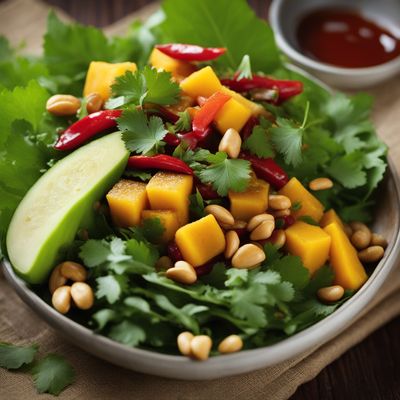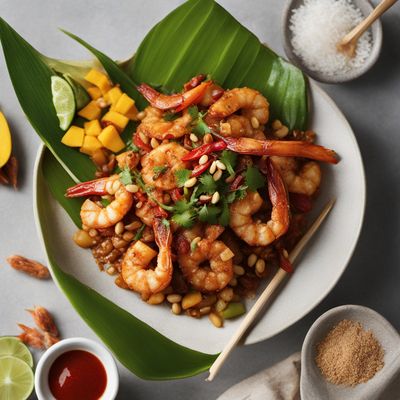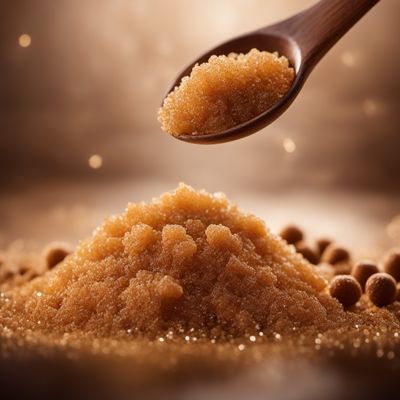
Ingredient
Brown palm sugar
The Sweet Essence of Nature: Exploring Brown Palm Sugar
Brown palm sugar, also known as jaggery or gula melaka, is a natural sweetener made from the sap of various palm trees. It is typically produced by boiling the sap until it thickens and solidifies into a dense, dark brown sugar. The texture of brown palm sugar can vary from soft and moist to hard and crystalline, depending on the production process. Its color ranges from light golden brown to deep, rich brown. The flavor of brown palm sugar is complex, with hints of caramel, toffee, and molasses. Its texture can be granular or sticky, depending on the variety. Brown palm sugar is often used in Southeast Asian, Indian, and Middle Eastern cuisines, where it is prized for its unique flavor and natural sweetness.
Origins and history
Brown palm sugar has a long history and is believed to have originated in Southeast Asia, particularly in Indonesia, Malaysia, and Thailand. It has been used for centuries in traditional cooking and is deeply ingrained in the culinary cultures of these regions. The production of brown palm sugar involves tapping the sap from palm trees, such as the coconut palm or the sugar palm, and then boiling it down to create the sugar. This traditional method of sugar production has been passed down through generations and continues to be practiced today.
Nutritional information
Brown palm sugar is a natural sweetener that contains essential minerals such as potassium, iron, and calcium. It is also a source of antioxidants and has a lower glycemic index compared to refined sugar.
Allergens
There are no known allergens associated with brown palm sugar.
How to select
When selecting brown palm sugar, look for a product that is dark brown in color, indicating a richer flavor. It should have a soft and moist texture, allowing for easy crumbling or slicing. Avoid products that are overly hard or dry, as they may have lost their freshness and quality.
Storage recommendations
To maintain the freshness and quality of brown palm sugar, store it in an airtight container in a cool, dry place. Avoid exposure to moisture, as it can cause the sugar to harden or clump together. If the sugar becomes hard, you can soften it by placing it in a microwave-safe bowl and heating it in short intervals until it becomes pliable again.
How to produce
Brown palm sugar is typically produced on a large scale by tapping the sap from palm trees and boiling it down to create the sugar. However, on a smaller scale, it can be produced by collecting the sap from a palm tree and simmering it until it thickens and solidifies into sugar.
Preparation tips
Brown palm sugar can be used in a variety of ways in the kitchen. It can be grated, shaved, or chopped to add sweetness and depth of flavor to desserts, sauces, marinades, and beverages. It dissolves easily in liquids, making it a convenient sweetener for hot or cold drinks. When using brown palm sugar in recipes, keep in mind that its flavor is more complex than regular white sugar, so you may need to adjust the quantities accordingly. Additionally, it pairs well with ingredients like coconut milk, ginger, and citrus fruits, enhancing their flavors.
Substitutions
A suitable substitute for brown palm sugar is dark brown sugar, which shares a similar flavor profile and can be used in equal amounts in most recipes.
Culinary uses
Brown palm sugar is commonly used in Southeast Asian cuisines, where it is an essential ingredient in dishes such as curries, stir-fries, and desserts. It adds a unique sweetness and depth of flavor to dishes like Thai mango sticky rice, Indonesian gado-gado, and Malaysian laksa. It can also be used to sweeten beverages like Thai iced tea or as a topping for desserts like creme brulee or flan.
Availability
Brown palm sugar is commonly available in Southeast Asian countries such as Indonesia, Malaysia, Thailand, and Singapore. It can also be found in specialty Asian grocery stores or online.
More ingredients from this category
Recipes using Brown palm sugar » Browse all

Javanese-style Spicy Shrimp Stew
Sambal Udang: A Fiery Delight of Javanese-style Spicy Shrimp Stew

Rujak Cuka - Indonesian Spicy Vinegar Salad
Fiery Fusion: Indonesian Spicy Vinegar Salad

Rujak Cingur with a Twist
Indonesian Delight: A Modern Twist on Rujak Cingur

Manado-style Habsburška Soup
Spicy Seafood Delight: Manado-style Habsburška Soup

Indonesian-style Coconut Rice Rolls
Coconut Delights: Indonesian Suman

Balinese-style Stuffed Chicken with Fragrant Spices
Ayam Betutu: Balinese Spiced Stuffed Chicken Delight

Thai-Inspired Pho
Tom Yum Pho: A Thai Twist on a Vietnamese Classic

Phuket-Style Spicy Crab Curry
Fiery Delight: Phuket's Spicy Crab Curry

Peranakan Cashew Candy
Nyonya Cashew Delight

Som Tam Khai Khem with a Twist
Spicy Thai Papaya Salad with Crispy Salted Eggs

Thai Spicy Beef Noodle Soup
Fiery Delight: Thai Spicy Beef Noodle Soup

Thai Coconut Sticky Rice in Bamboo
Coconut-infused Delight: Thai Bamboo Sticky Rice

